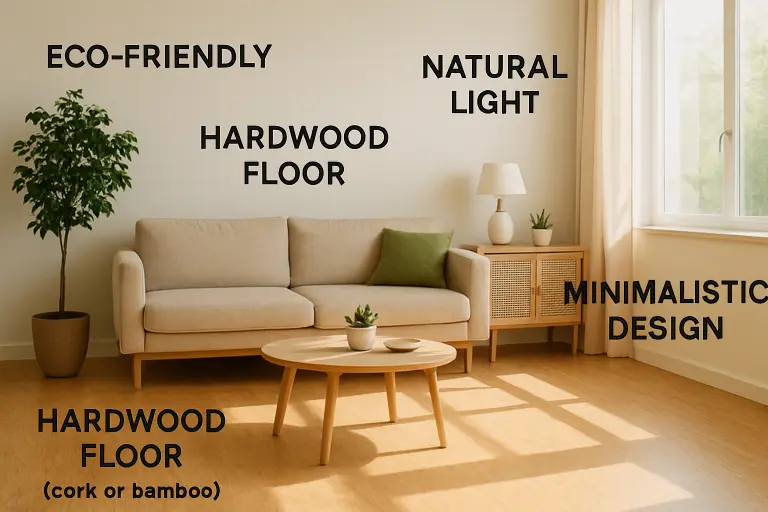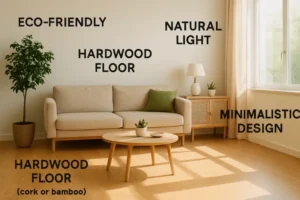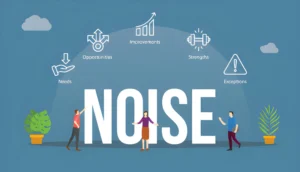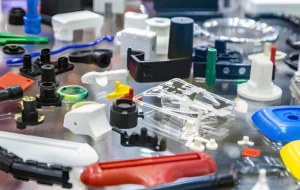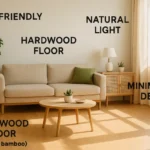Key Takeaways
- Eco-friendly materials like bamboo and cork offer renewability and strength.
- Reclaimed wood introduces a unique charm and fosters conservation by reducing demands on new resources.
- Low-VOC and plant-derived finishes enhance indoor air quality and environmental well-being.
- Contemporary design techniques, including intricate layouts and textured surfaces, enable a personal and eco-conscious flooring style.
Table of Contents
- Introduction
- Eco-Friendly Materials: Bamboo and Cork
- Reclaimed Wood: Vintage Charm Meets Sustainability
- Low-VOC and Plant-Based Finishes
- Innovative Patterns and Textures
- Certifications: Ensuring Responsible Choices
- Conclusion
Environmental consciousness shapes many decisions in home design today, including flooring choices. Modern homeowners no longer view hardwood flooring as a purely aesthetic decision; there’s a strong desire to create comfortable spaces while minimizing environmental impact. That’s why more designers and families are exploring innovative, eco-friendly options that are both beautiful and responsible. Choosing the right materials and finishes can transform your living areas while positively impacting the planet. If you’re starting your flooring journey in Colorado, SOEN Hardwood Denver offers valuable expertise on sustainable hardwood flooring solutions. Advancements in materials, such as rapidly renewable woods and salvaged lumber, make it possible to enjoy gorgeous floors with a smaller ecological footprint. New finishes, bold patterns, and texture techniques further expand the options available to today’s conscious consumer. Whether you’re remodeling a century-old home or outfitting a modern loft, integrating sustainable practices not only elevates your space—it supports a healthier future for all.
Eco-Friendly Materials: Bamboo and Cork
Bamboo and cork have rapidly become leading choices for eco-conscious flooring. Bamboo is not only stylish—it’s also incredibly sustainable, as it can be harvested every 3–5 years without replanting. Its tough fibers provide durability that rivals traditional hardwoods, making it ideal for busy households. Bamboo’s moisture resistance adds further appeal in kitchens, bathrooms, and basements. Cork offers equally compelling sustainability advantages. Harvested from the bark of cork oak trees (which naturally regenerates), cork extraction is gentle on forests and ecosystems. Its natural elasticity feels gentle underfoot and provides sound dampening and thermal insulation, factors especially valued in multi-story dwellings or high-traffic areas. These materials have drawn praise among designers and environmental advocates.
Reclaimed Wood: Vintage Charm Meets Sustainability
For homeowners who crave both authenticity and environmental responsibility, reclaimed wood offers a unique proposition. This lumber is sourced from old barns, warehouses, and industrial spaces, and every board tells a different story with weathered textures, saw marks, and historic patinas. Reclaimed wood flooring is valued for its durability—wood salvaged from bygone eras is often more rigid and more stable than newly cut timber, having already stood the test of time. Repurposing old wood reduces demand for new logging, thus conserving habitats and decreasing landfill waste. It’s no surprise that reclaimed wood is a favorite of both interior designers and sustainability experts. Reclaimed wood is appreciated not only for its provenance but also for the environmental benefits it offers to eco-driven renovation projects.
Low-VOC and Plant-Based Finishes
Surface finishes are a crucial but sometimes overlooked component of sustainability in hardwood flooring. Many classic wood sealants and stains release volatile organic compounds (VOCs), which can contribute to indoor air pollution and negatively impact respiratory health—especially for families with children or individuals with allergies. Modern advances have led to a wide variety of low-VOC and even plant-based finishes that protect both your hardwood floors and your indoor environment. Eco-friendly finishes minimize harmful emissions and still offer excellent durability and beauty. They come in many sheens and highlight the wood’s natural grain without yellowing or clouding over time. These alternatives ensure that environmentally responsible floors stay healthy and attractive for years to come.
Innovative Patterns and Textures
Design trends in sustainable hardwood flooring extend far beyond the choice of material. Increasingly, homeowners are opting for bold layouts and artisanal textures to add personal flair without compromising on eco-friendliness. Herringbone and chevron patterns, once reserved for grand estates, have made a resurgence in modern applications, adding visual movement and sophistication to living spaces. In addition to patterns, textured finishes, such as wire brushing and hand scraping, continue to gain popularity. These techniques add tactile interest while disguising minor dents or scratches, making them practical for households with active lifestyles. Artful innovation in design allows homeowners to achieve a custom look that is simultaneously chic and sustainable.
Certifications: Ensuring Responsible Choices
Certifications provide peace of mind regarding the origins and manufacturing processes behind hardwood flooring. For wood products, the Forest Stewardship Council (FSC) certification ensures that timber is sourced from responsibly managed forests, with a focus on biodiversity, wildlife conservation, and the protection of local communities. GreenGuard certification is another key marker, ensuring that flooring materials meet stringent criteria for low chemical emissions, thereby safeguarding indoor air quality. UL GREENGUARD Certification helps demonstrate compliance with chemical emission standards and a commitment to healthier indoor environments. Choosing flooring with reputable certifications helps ensure your renovation supports both environmental and health goals. Whenever shopping for new hardwood, always ask for documentation to verify that these third-party standards are met.
Conclusion
Choosing sustainable trends in modern hardwood flooring empowers homeowners to create stylish, healthy spaces while supporting global conservation efforts. Renewable materials like bamboo and cork, character-rich reclaimed wood, eco-friendly finishes, and thoughtful designs all contribute to a greener future. By prioritizing well-sourced, responsibly produced flooring—supported by recognized certifications—you can enjoy comfort, beauty, and a cleaner planet for years to come.
Also Read-Snow Removal Safety Tips Every Homeowner Should Know
